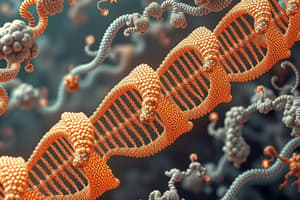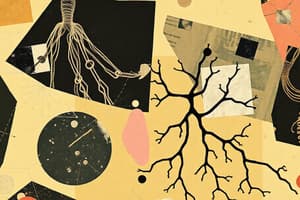Podcast
Questions and Answers
What type of proteins do free polyribosomes primarily synthesize?
What type of proteins do free polyribosomes primarily synthesize?
- Proteins for lysosomal storage
- Proteins secreted from the cell
- Cytosolic and cytoskeletal proteins (correct)
- Proteins for cell membrane incorporation
What is targeted for degradation by proteasomes when misfolded?
What is targeted for degradation by proteasomes when misfolded?
- Ubiquitin-conjugated proteins (correct)
- Cytoskeletal proteins
- Ribosomes
- Proteins synthesized by ribosomes
Which mechanism describes the elongation and turnover of actin filaments?
Which mechanism describes the elongation and turnover of actin filaments?
- Stabilization at their ends
- Dynamic equilibrium of microtubules
- Treadmilling of actin filaments (correct)
- Segregation of proteins in the ER
What is the primary function of the unfolded protein response (UPR)?
What is the primary function of the unfolded protein response (UPR)?
What determines the fate of newly synthesized proteins?
What determines the fate of newly synthesized proteins?
How do proteins synthesized in the rough endoplasmic reticulum differ from those made by free ribosomes?
How do proteins synthesized in the rough endoplasmic reticulum differ from those made by free ribosomes?
Which cytoskeletal component is primarily involved in cellular movement?
Which cytoskeletal component is primarily involved in cellular movement?
What role do cytoskeletal dynamics play in the cell?
What role do cytoskeletal dynamics play in the cell?
Flashcards
Protein Synthesis
Protein Synthesis
The process by which cells create proteins. It begins with DNA transcription and involves the formation of messenger RNA (mRNA), which carries genetic information from DNA to ribosomes, where protein synthesis takes place.
Translation
Translation
The process by which ribosomes attach to mRNA and synthesize proteins. Free ribosomes produce proteins that remain in the cytosol, while ribosomes bound to the endoplasmic reticulum (ER) produce proteins that are destined for the ER lumen, secretion, or integration into membranes.
Signal Hypothesis
Signal Hypothesis
A hypothesis that explains how proteins are targeted to specific locations within a cell. The signal hypothesis proposes that proteins destined for the ER, secretion, or membranes contain a signal sequence, a short stretch of amino acids that directs the ribosome to bind to the ER membrane.
Unfolded Protein Response (UPR)
Unfolded Protein Response (UPR)
Signup and view all the flashcards
Proteasome
Proteasome
Signup and view all the flashcards
Cytoskeleton
Cytoskeleton
Signup and view all the flashcards
Treadmilling of Actin Filaments
Treadmilling of Actin Filaments
Signup and view all the flashcards
Dynamic Instability of Microtubules
Dynamic Instability of Microtubules
Signup and view all the flashcards
Study Notes
Cell Biophysiology - Learning Objectives
- Describe protein synthesis
- State the fate of proteins synthesized in the rough endoplasmic reticulum (rER) and those synthesized by free ribosomes
- Explain the "signal hypothesis" in protein synthesis
- List factors determining the fate of newly synthesized proteins
- Explain the function of the unfolded protein response (UPR) and its importance to the cell
- Compare protein degradation mechanisms using proteasomes or lysosomes
- Explain the cytoskeleton's role in cell shape, organelle positioning, intracellular trafficking, and movement
- Compare the characteristics and functions of microfilaments, microtubules, and intermediate filaments
- Explain treadmilling of actin filaments and dynamic instability of microtubules
- Explain how cytoskeletal dynamics control cellular movement
- Identify and correlate organelles with their functions
Chromatin structure
- Chromatin is DNA bound to histones and other proteins
- Chromatin exists in two forms:
- Heterochromatin: Condensed chromatin, transcriptionally inactive, appears intensely stained
- Euchromatin: Dispersed, unpacked chromatin, often actively transcribed, appears lightly stained
- Nucleolus: Site of ribosomal RNA (rRNA) transcription and ribosome production; appears intensely stained
Constitutive and Facultative Heterochromatin
- Constitutive heterochromatin: Repetitive, stays condensed throughout the cell cycle
- Facultative heterochromatin: Non-repetitive, can lose condensed state and become transcriptionally active
Centrosome and Centriole
- Centrosome: Microtubule organizing center in animal cells, consisting of:
- Centrioles: Orthogonal pairs of centrioles
- Pericentriolar material (PCM): Amorphous mass of proteins; responsible for microtubule anchoring. Cylindrical structure, ~200 nm in diameter, composed of nine triplets of microtubules
Polyribosomes (Polysomes)
- Multiple ribosomes bound to a single mRNA molecule
- Simultaneously translate mRNA into many protein copies
Polyribosomes: Free and ER-Bound
- Free polyribosomes synthesize cytosolic and cytoskeletal proteins and proteins for import into the nucleus, mitochondria, and peroxisomes
- ER-bound polyribosomes synthesize proteins for incorporation into membranes, storage in lysosomes, and secretion from the cell
Protein Synthesis - Signal Hypothesis
- Signal hypothesis describes protein translocation into the endoplasmic reticulum (ER)
- Signal peptide: Sequence at the N-terminus of a protein targeted for the ER
- Signal recognition particle (SRP): Binds to the signal peptide
- SRP-receptor binds to the SRP, halting translation
- Ribosome-translocator complex: Ribosome docks on the ER membrane
- Signal peptidase: Removes the signal peptide
- Chaperones: Assist with proper polypeptide folding in the ER cisterna
ER-Associated Degradation (ERAD)
- ERAD pathway degrades misfolded or unfolded proteins
- Ubiquitin proteins are conjugated to misfolded proteins
- Degraded by proteasomes
Unfolded Protein Response (UPR)
- UPR triggers when unfolded proteins accumulate in the ER
- Adjusts the number of proteins that need to be folded
- Increases endoplasmic reticulum's protein folding ability
- Removes proteins that take longer to fold
Ubiquitin-Proteasome Pathway
- Ubiquitin-protein ligation: Ubiquitin attached to a protein via enzymes
- Recognition of the ubiquitin-conjugated protein by the 26S proteasome
- Degradation of the ubiquitin-conjugated protein by the 26S proteasome
- Release and recycling of ubiquitin
- Disassembly of the polyubiquitin chain
Self-Study Slides
- Organelle identification and correlating with function
Studying That Suits You
Use AI to generate personalized quizzes and flashcards to suit your learning preferences.




